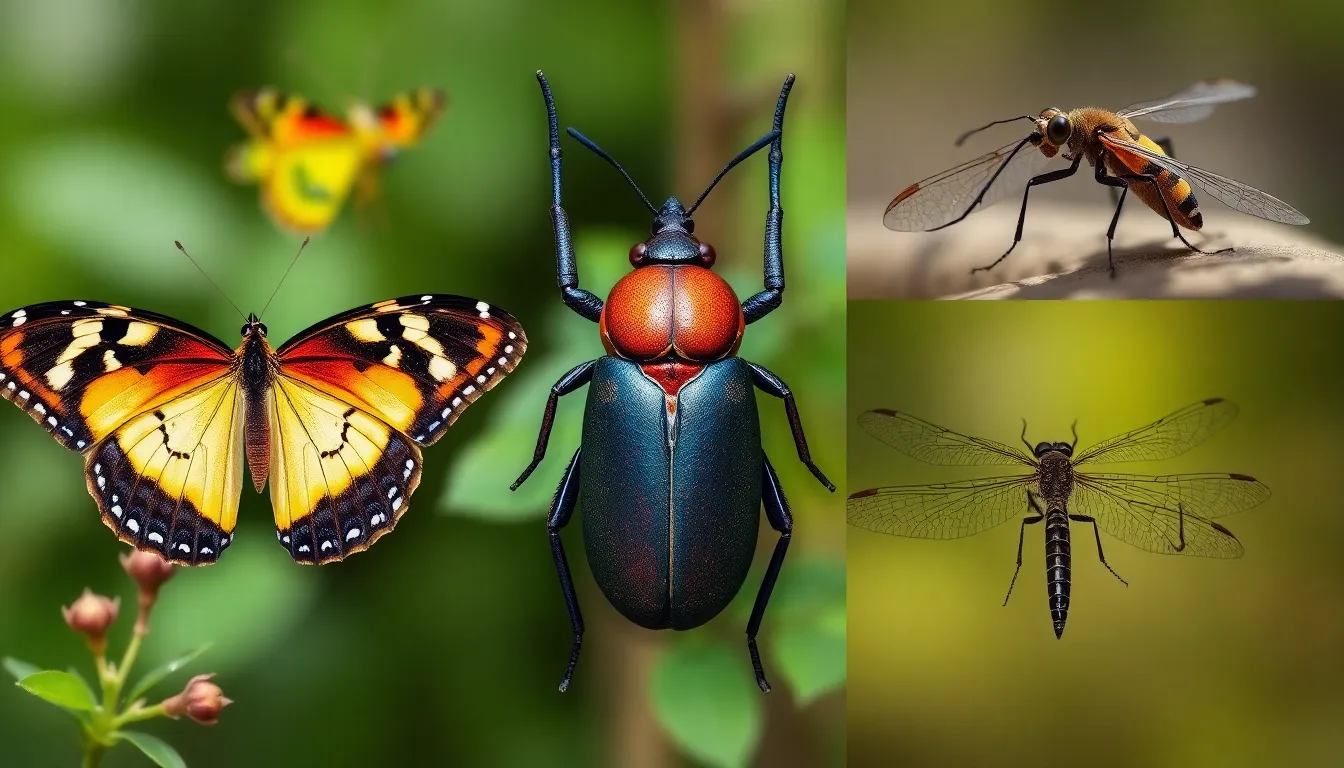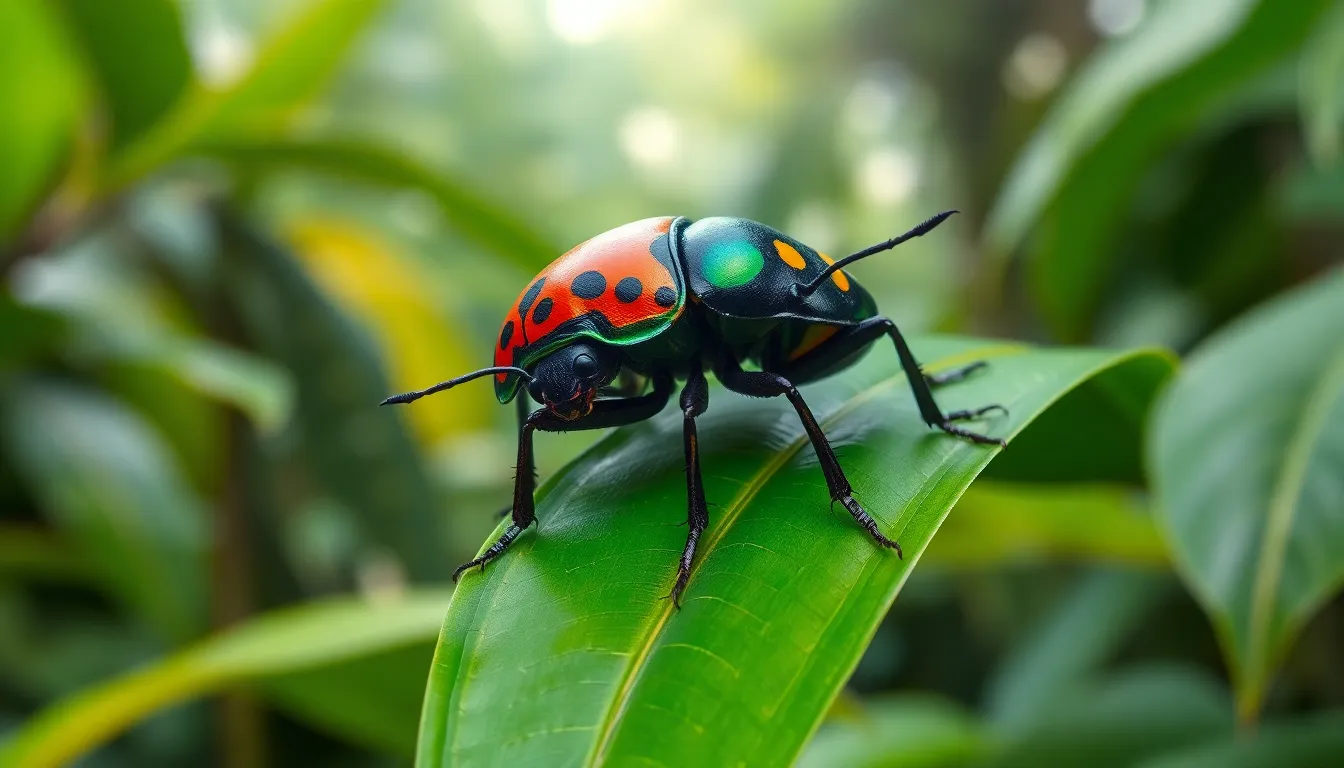Imagine stepping into a world where bugs aren’t just tiny nuisances but colossal creatures that could make a toddler scream. Large insects, with their impressive size and unique features, are nature’s way of reminding us that size does matter—at least in the insect kingdom. From the majestic Goliath beetle to the terrifyingly large tarantula hawk wasp, these giants command attention and spark curiosity.
Large Insects
Large insects embody a remarkable diversity within the insect world. Goliath beetles, for instance, can weigh up to 3.5 ounces and measure about 4.3 inches in length. Tarantula hawk wasps possess impressive wingspans, reaching around 2 inches. These giants inhabit various ecosystems around the globe, displaying unique adaptations that allow for their survival.
Physical features of large insects often include exaggerated mandibles and robust bodies. Goliath beetles possess strong jaws that enable them to feed on plant material and decaying wood. Moreover, adaptations like larger wings support flight, which is essential for finding food and evading predators.
Behaviorally, large insects often exhibit fascinating traits. Many are solitary, while others display social behavior, such as certain wasps and ants. Social structures in these species highlight the complexity of their interactions, from foraging to defense.
Habitats for large insects vary significantly. Tropical rainforests often host various species, providing the necessary resources and climate. Conversely, deserts may support some larger beetles, adapted to extreme conditions.
Roles in ecosystems differ as well. Large insects act as pollinators, decomposers, and prey for larger animals. Goliath beetles contribute to pollination by visiting flowers and transferring pollen. Additionally, they serve as food for birds and mammals, illustrating the interconnectedness of life.
Understanding large insects illuminates their ecological importance and evolutionary adaptations. Observing these insects challenges common perceptions of the insect world and underscores their value within ecosystems.
Types Of Large Insects

Large insects come in various forms, showcasing extraordinary features and behaviors. Each type plays an essential role in its ecosystem.
Beetles
Beetles represent one of the most diverse insect orders. Goliath beetles, for example, can weigh up to 3.5 ounces and reach lengths of approximately 4.3 inches. Their robust bodies and potent mandibles access a variety of food sources. Additionally, the Hercules beetle is another impressive species, boasting lengths over 7 inches, primarily found in Central and South America. These insects exhibit a wide range of colors and patterns, aiding in camouflage and mating displays.
Butterflies And Moths
Large butterflies and moths capture attention with their vibrant colors and intricate wing patterns. The Queen Alexandra’s birdwing butterfly, recognized as the largest butterfly globally, can have a wingspan of up to 12 inches. These stunning insects play vital roles as pollinators while also acting as prey for other animals. Moths, such as the Atlas moth, can rival butterflies in size and reach wingspans of up to 10 inches. Their nocturnal activities often lead to unique adaptations, including pheromone release for mating.
Dragonflies
Dragonflies are known for their impressive aerial agility and predatory skills. Some species can have wingspans surpassing 5 inches, allowing for swift movement through their environments. The Titan darner exemplifies this size, being one of the largest North American species. Capable of consuming a wide variety of insects, dragonflies contribute significantly to controlling pest populations. Mating behaviors among these insects are complex, often involving elaborate flights to attract partners. Their presence indicates healthy aquatic ecosystems, often found near freshwater sources.
Habitats Of Large Insects
Large insects thrive in diverse environments, each habitat offering unique resources and challenges.
Tropical Regions
Tropical regions serve as prime habitats for many large insect species. Rich biodiversity supports insects like the Goliath beetle and various giant butterflies. Dense foliage offers ample food sources and shelter from predators. Humid conditions foster growth, enabling insects to reach significant sizes. For instance, large tree trunks and undergrowth provide hiding spots while promoting competition for food. Additionally, the complex ecosystems in these regions facilitate interactions between large insects and their prey, pollinators, or decomposers. Such dynamics highlight the adaptability of these insects to their surroundings.
Urban Environments
Urban environments host surprisingly large insect populations. Cities, with their gardens, parks, and green structures, offer food and nesting opportunities for species like dragonflies and moths. Adaptive traits allow these insects to thrive in human-altered landscapes. Urban heat islands often create microclimates that support larger populations. Buildings provide shelter while attracting smaller insect prey, benefiting larger predators. For example, balcony gardens support significant moth and butterfly species, playing essential ecological roles even in bustling cities. This adaptability underscores the resilience of large insects amidst human activity.
The Role Of Large Insects In Ecosystems
Large insects are vital components of their ecosystems, contributing significantly as pollinators. Various species, like the Hercules beetle, take part in plant reproduction by transferring pollen among flowers. This activity enhances biodiversity and ensures the survival of numerous plant species.
Decomposers also rely on large insects for their roles in breaking down organic matter. Species such as giant wood-boring beetles recycle nutrients back into the soil, promoting ecosystem health. Their ability to dismantle decaying plants and animals expedites nutrient cycling and enhances soil quality.
Predators and prey form another important ecological relationship that large insects maintain. Tarantula hawk wasps, for instance, serve both as predators of spiders and as prey for birds, reptiles, and small mammals. This interdependence demonstrates their place in the food web and underscores the balance within ecosystems.
Certain large insects, like dragonflies, significantly impact pest populations by controlling mosquitoes and other troublesome insects. Their predation helps maintain population equilibrium, reducing the spread of diseases and enhancing human comfort in various environments.
Adaptations exhibit remarkable evolutionary traits among large insects. Exaggerated mandibles on beetles showcase their strength when competing for food or mating opportunities. Colorful wings on large butterflies attract mates and serve as camouflage strategies, enabling survival.
Urban areas surprisingly host large insect populations, creating new ecological niches. The presence of dragonflies and moths in cities exemplifies how these insects adapt to human-altered environments. This adaptability reveals their resilience and emphasizes their ecological significance in diverse habitats.
Large insects undeniably possess essential functions that maintain ecological balance, showcasing their importance in the natural world. Their diverse roles contribute to healthy ecosystems worldwide, demonstrating the necessity of preserving their populations.
Fascinating Facts About Large Insects
Large insects display remarkable characteristics that capture the imagination. Goliath beetles, for instance, can weigh up to 3.5 ounces and measure about 4.3 inches in length. Such dimensions make them among the largest beetles globally. Tarantula hawk wasps add to this intrigue with wingspans reaching around 2 inches. These impressive sizes highlight unique evolutionary adaptations.
Many large insects inhabit tropical rainforests, where rich biodiversity thrives. Despite this preference, urban environments also support large insect populations. Cities provide essential food sources and nesting opportunities, showcasing the adaptability of these creatures. Dragonflies, which often reside near water bodies, can reach wingspans exceeding 5 inches. Their presence in diverse habitats emphasizes their ecological significance.
Roles in ecosystems underscore the importance of large insects. Pollinators like giant butterflies and wasps significantly contribute to plant reproduction. For example, the Hercules beetle plays a vital part in maintaining healthy ecosystems by enhancing soil quality. Moths such as the Atlas moth, with wingspans up to 10 inches, also serve crucial roles in pollination.
Behavior among large insects varies significantly. Some species exhibit solitary traits, while others like ants may display complex social interactions. Giant wood-boring beetles facilitate nutrient recycling, while predatory insects like tarantula hawk wasps maintain ecological balance. Observing these intricate behaviors deepens appreciation for the roles large insects play in nature.
Conclusion
Large insects are not just fascinating due to their size but also for their vital roles in ecosystems. They contribute to pollination, nutrient recycling, and pest control, making them indispensable for environmental health. Their unique adaptations and behaviors enrich the biodiversity of our planet.
Recognizing the importance of these giant creatures can shift perceptions and inspire a deeper appreciation for the natural world. Protecting their habitats ensures the continuation of these remarkable species and the ecological balance they help maintain. Embracing the diversity of large insects ultimately fosters a greater understanding of life on Earth.

